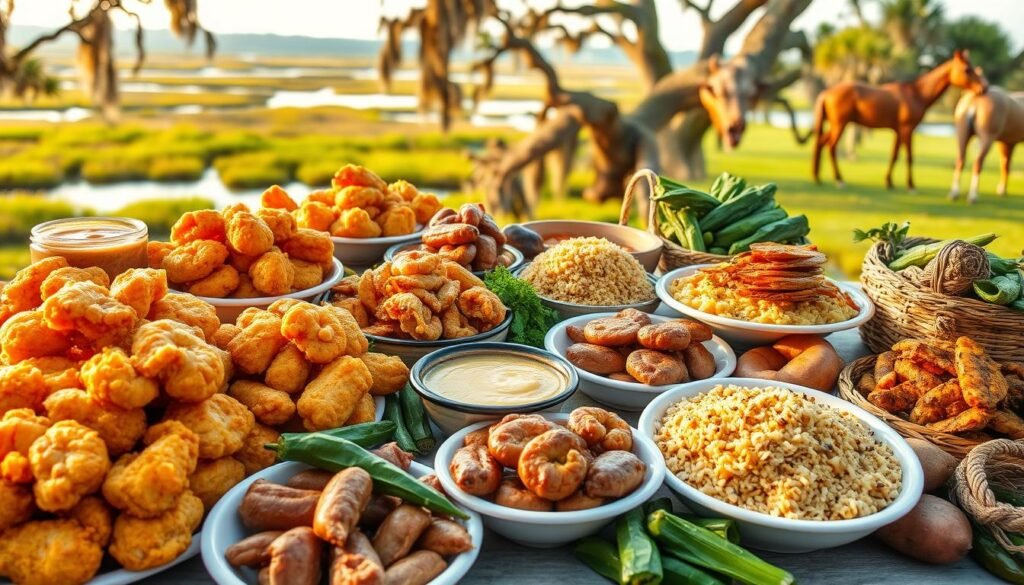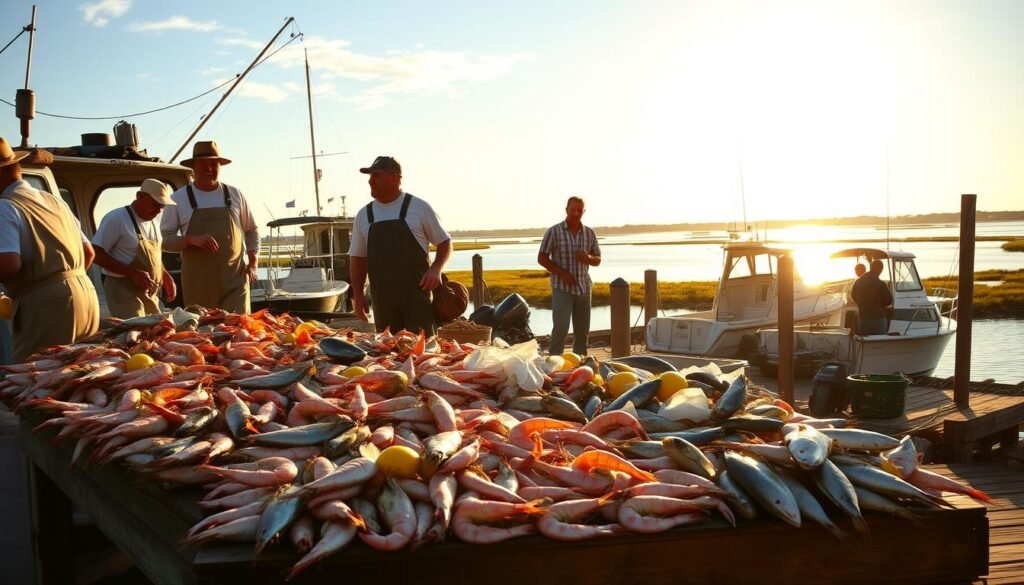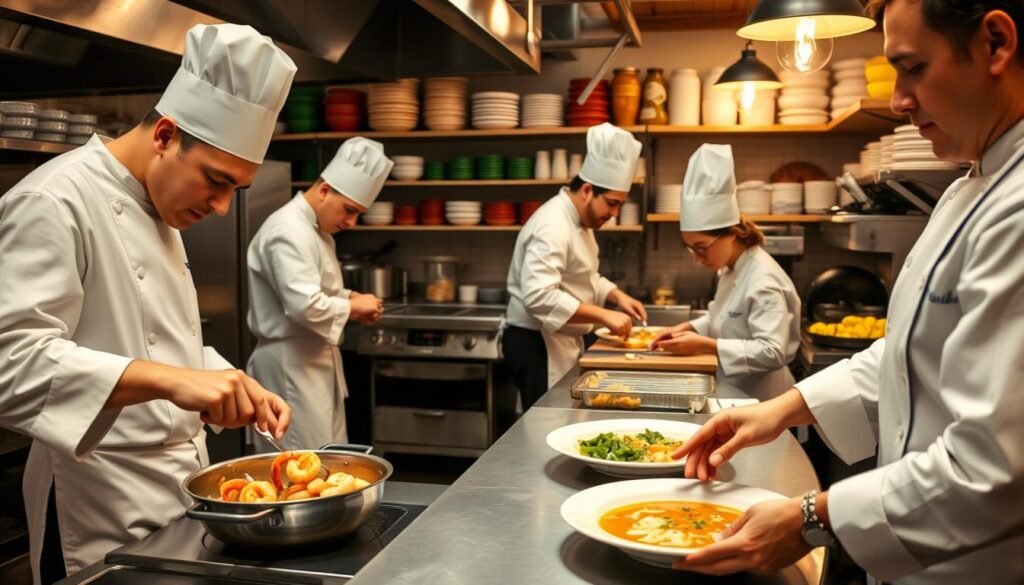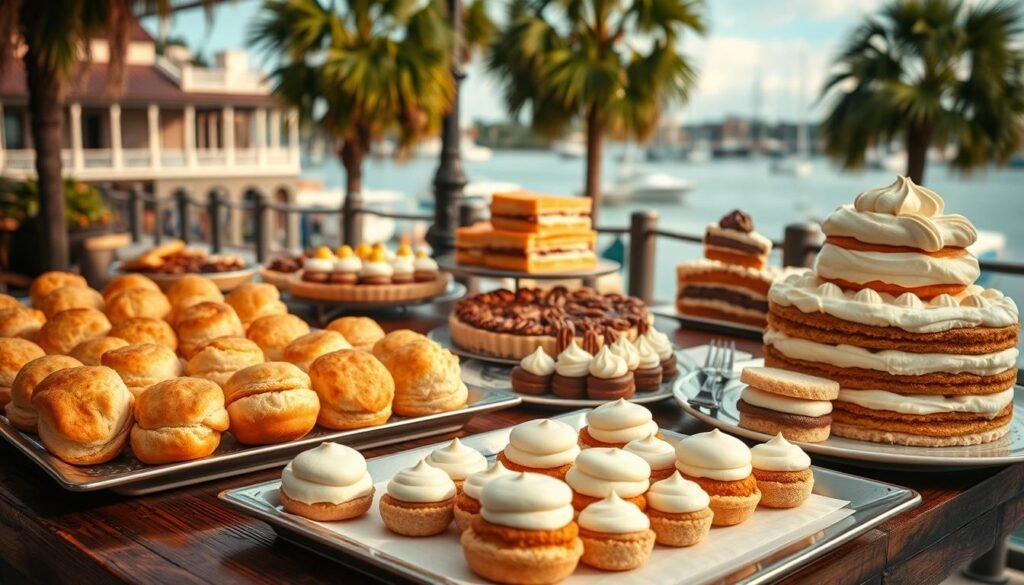Step into Charleston, where every bite tells a story. The city’s culinary soul thrums in the aroma of shrimp and grits. It also lives in the spicy tang of she-crab soup and the earthy crunch of benne wafers. This is Lowcountry cuisine—a vibrant blend of Gullah Geechee traditions, European influences, and the fresh bounty of the coast. A culinary tour of Charleston shows how every dish here is a bridge between past and present. It ties generations of cooks and cultures into one unforgettable tapestry.
Walking the cobblestone streets, you’ll find restaurants where Lowcountry cuisine meets innovation. From historic rice plantations to today’s farm-to-table kitchens, Charleston’s food heritage is alive in every spoonful. This journey through South Carolina gastronomy isn’t just about eating—it’s about tasting the legacy of a place. Here, oysters from the Ashley River meet heirloom ingredients like Carolina Gold rice.
Key Takeaways
- Charleston’s food reflects a fusion of Gullah Geechee, European, and coastal traditions.
- Iconic dishes like frogmore stew and benne seed cakes highlight the region’s culinary identity.
- Charleston food tours reveal stories of resilience and cultural exchange in every recipe.
- South Carolina gastronomy prioritizes seasonal ingredients and sustainable practices.
- Explore how modern chefs honor Lowcountry cuisine while reimagining its flavors.
The Storied Origins of Lowcountry Cuisine
Walking through Charleston’s markets, I’m struck by the stories in every aroma and flavor. The Lowcountry’s food history is rich, blending Gullah Geechee cuisine with colonial traditions. It’s a place where history is in every dish, from ancient rice paddies to today’s top kitchens.
Gullah Geechee Influences on Charleston’s Food Culture
The Gullah Geechee legacy is at the heart of this heritage. Enslaved Africans brought okra, rice, and benne seeds to the region. These ingredients became key to local dishes like hoppin’ john and veggie stews. They are the essence of Lowcountry culinary origins.
- Okra: Introduced as a thickener for soups
- Benne seeds: Symbolizing hope in Gullah culture, now used in candies and oils
- Rice: The backbone of Carolina’s agricultural economy
Colonial European Contributions to Lowcountry Flavors
European settlers added their own traditions to the mix. English and French methods merged with Spanish spices. This created Creole-like dishes that blended European techniques with local ingredients.
| European Influence | Culinary Impact |
|---|---|
| English | Rice cultivation techniques, hearty stews |
| French | Pastry arts, gumbo variations |
| Spanish | Use of citrus and saffron in seafood dishes |
The Evolution of Charleston’s Culinary Identity
Over time, these influences shaped a unique culinary identity. The Charleston food evolution spans from old plantations to today’s farm-to-table movement. Chefs now update classics like shrimp and grits while keeping their roots alive.
| Timeline | Key Milestone |
|---|---|
| 1700s | Gullah rice dishes become regional staples |
| 1800s | Colonial trade routes introduce Caribbean spices |
| 2000s | Renaissance of heirloom ingredients like Carolina Gold Rice |
Every bite here is a story of past and present. Exploring Charleston food history shows how tradition and innovation come together in every dish.
Why Charleston Has Become a Gastronomic Destination
Walking through Charleston’s streets, you’ll catch the scent of Lowcountry flavors. These smells tell a tale of old traditions and new twists. Plan your visit to see how best Charleston restaurants turn simple dishes like shrimp, grits, and benne into masterpieces. The Charleston food scene is alive, thanks to top Charleston chefs like Sean Brock of Husk. They mix old recipes with new ideas, winning Charleston food awards from the James Beard Foundation.
| Category | Highlights | Examples |
|---|---|---|
| Local Ingredients | Fresh seafood, heirloom grains | Shrimp, Carolina Gold Rice, wild-caught oysters |
| Culinary Innovation | Fusion of Gullah Geechee roots with global techniques | Husk’s foraged dishes, FIG’s seafood mastery |
| Award-Winning Excellence | James Beard Awards, Michelin stars | 10+ chef awards, 5-star farm-to-table spots |
Every bite here has a story. Whether it’s she-crab soup at an old market or craft cocktails with local flavors. The Charleston food scene is more than just eating—it’s diving into a culture. It’s where every dish respects its roots while looking to the future. From the best Charleston restaurants to lively markets, Charleston shows that food is both a tradition and a new beginning.
Signature Lowcountry Dishes You Can’t Miss
My first taste of must-try Charleston dishes was a steaming bowl of grits. These dishes are more than food—they’re family treasures. The Lowcountry’s flavors tell its story, from the sea to smoky kitchens. 
Shrimp and Grits: The Quintessential Charleston Dish
Once a simple fisherman’s breakfast, best shrimp and grits Charleston now dazzle in fancy restaurants. Silky grits are topped with shrimp and Andouille, all balanced by tangy tomato gravy. At Husk, the grits are creamy perfection with local shrimp, showing its journey from simple to sophisticated.
She-Crab Soup: A Creamy Delicacy
Authentic She-Crab soup whispers of Charleston’s Gilded Age. It’s a mix of creamy crab meat and roe with sherry’s warmth. The Ordinary’s version keeps this elegance alive, with its golden broth.
Oysters: Harvested from Local Waters
Charleston oysters are a taste of the sea. From Wadmalaw Island, they burst with brininess at Hogs & Hominy. Whether grilled or raw, their freshness captures coastal living.
Frogmore Stew: The Ultimate Lowcountry Boil
The smell of Frogmore stew recipe fills kitchens at family gatherings. It’s a mix of shrimp, sausage, and corn that simmers until flavors blend. Leon’s Market & Cuisine offers it as a modern take, honoring its roots.
Each dish is a guide to Charleston’s heart. Enjoying them is like exploring centuries of Lowcountry history, one bite at a time.
The Essential Culinary Tour of Charleston, South Carolina
Walking through Charleston feels like opening a recipe book. My culinary adventure starts with Charleston food tours. These tours turn streets into paths of discovery. They mix history with flavors, inviting you to taste the city’s layers.
Start in the Charleston historic district restaurants. Places like Callie’s in the French Quarter serve shrimp and grits that tell stories. Join a culinary walking tour to see how old kitchens and traditions blend into today’s dishes. Each bite is a chat with the past.
Historic District Food Walks
Begin at 82 Queen, where old flavors meet new. Their oyster happy hour is perfect with the area’s old buildings. Nearby, Hominy Grill has she-crab soup in a place where every table has a story.
Market Area Culinary Experiences
The Charleston City Market food is a must-see. Try benne wafers at the stalls, then visit Market Street’s Callie’s sister spot. Their shrimp and grits are a twist on tradition, enjoyed with market sounds.
Off the Beaten Path Neighborhood Eats
Explore hidden gem restaurants Charleston beyond the main area. On Sullivan’s Island, Callie’s Seafood Shack offers boiled peanuts and fried oysters with Atlantic views. In North Charleston, The Ordinary mixes soul food with farm-to-table dishes.
| Neighborhood | Must-Try Spot | Signature Dish |
|---|---|---|
| Sullivan’s Island | Callie’s Seafood Shack | Boiled blue crabs with Old Bay |
| North Charleston | The Ordinary | Collard green lasagna |
| Harleston Village | High Cotton | Lowcountry boil with heirloom grains |
Every corner has a story to tell through taste. Let your taste guide you through this mix of history and new flavors.
From Sea to Table: The Importance of Fresh Seafood
Waking at dawn, I’ve seen fishing boats come in with nets full of fresh seafood. The salty air smells of the day’s catch—sweet shrimp, plump crabs, and local fish like redfish and flounder. This is the heart of fresh South Carolina seafood, a tradition in the Lowcountry.

Charleston’s spot where rivers meet the Atlantic is perfect for many fish species. Shrimp come in summer, oysters in winter, and flounder all year. Chefs and fishermen here live by the sea’s rhythm. “We don’t just harvest—we steward,” said a fisherman at the Old Town Marina. “The ocean feeds us; we must feed it back with care.”
“Sustainability isn’t a trend—it’s survival. Every catch must leave room for tomorrow’s.”
Charleston seafood restaurants like those in pan-seared sea bass with roasted beetroot follow this rule. They work directly with local boats, making sure each dish honors tradition and the environment. This way, they serve flavors that truly capture the sea’s essence, not just its surface.
At the Fish Market, I’ve seen chefs and home cooks trace fish origins like family trees. This shows the Lowcountry seafood culture—a connection between water, plate, and community. When you eat a perfectly grilled local fish, you’re tasting centuries of stories, not just seasoning.
Every bite is a promise: to the ocean’s health, the fisher’s skill, and your taste buds. That’s how Charleston keeps its seafood legacy alive—one fresh, ethical catch at a time.
Charleston’s Revival of Heirloom Ingredients
Walking through Charleston’s markets, I’ve seen heirloom ingredients become stars. Chefs and farmers now celebrate crops like Carolina Gold rice and Sea Island Red Peas. They bring new life to dishes that once defined the Lowcountry.
This revival is more than nostalgia. It’s a bridge between past and present. It preserves taste and tradition.
Carolina Gold Rice: The Grain That Built a Culture
Carolina Gold rice dishes are now on menus everywhere. This grain, almost lost by the 20th century, is celebrated for its unique flavor and texture. Anson Mills leads its revival, working with chefs to create dishes like rice pudding with benne seed crunch.
“It’s not just rice—it’s history,” says Charleston chef Sam Kelemer. He uses it for his Lowcountry food preservation projects.
Sea Island Red Peas: A Lowcountry Staple Reborn
Sea Island Red Peas recipes are now in modern kitchens. They have their roots in Gullah Geechee kitchens. These legumes, once a survival crop, now shine in dishes like Hoppin’ John and pea gravies.
At High Cotton, they’re blended into a red pea purée with local shrimp. It’s a nod to tradition with a modern twist.
Benne Seeds: Africa’s Gift to Charleston Cuisine
Charleston bakers and mixologists love benne seeds. Once a symbol of resilience, they now flavor biscuits and sauces. Their journey from West Africa to Charleston’s kitchens tells a layered story.
| Ingredient | Historic Role | Modern Applications |
|---|---|---|
| Carolina Gold Rice | 18th-century cash crop | Contemporary Carolina Gold rice dishes like risottos |
| Sea Island Red Peas | Gullah Geechee sustenance | Sea Island Red Peas recipes in farm-to table tasting menus |
| Benne Seeds | African diaspora crop | Benne seeds Charleston in desserts and savory sauces |
These ingredients are more than relics. They’re living links to the past. Through preservation efforts, they’re now key in South Carolina festivals and tasting menus. Their revival honors the hands that first planted the seeds.
The Rise of Charleston’s Celebrity Chefs
When I walked into a restaurant, Sean Brock’s shrimp and grits caught my eye. It showed how visionaries turned Lowcountry soil into a culinary movement. The Charleston food renaissance started with pioneers who made dishes that now appear on Food Network and Michelin guides.

Pioneers of the Charleston Food Renaissance
Frank Lee’s FIG restaurant was a key spot for Charleston restaurant pioneers. They mixed Gullah Geechee roots with French techniques. Sean Brock and Ed Lee’s Husk became famous, showing Lowcountry ingredients could compete with any cuisine.
Their cookbooks and PBS specials made them Charleston culinary celebrities. They shared stories of benne seeds and heirloom rice with the world.
New Voices Reshaping Lowcountry Traditions
Today, chefs like Michelle Galloway and BJ Dennis add new flavors to shrimp and grits. Think coconut curry or West African spices. At modern Lowcountry tables, they mix global flavors with tradition.
At places like Callie’s or Heritage, their dishes show heritage and innovation together. These chefs make Charleston’s tables both timeless and bold.
From farm visits to TV screens, they keep Charleston’s culinary scene alive. They turn the Lowcountry into a global culinary conversation.
Sweet Southern Endings: Charleston’s Dessert Traditions

Walking through Charleston’s cobblestone streets, the scent of caramelized sugar and toasted nuts draws me to its historic Charleston pastries. From Lowcountry sweets baked in 18th-century recipes to modern twists on Southern dessert recipes, each bite tells a story. At Charleston dessert spots like Peninsula Grill, the iconic seven-layer coconut cake dazzles with its buttercream cascades—a decadent finale that blends Caribbean coconut with Lowcountry flair.
- Huguenot Torte: Crisp pecan crust filled with seasonal fruit, a French-Huguenot legacy reborn with local peaches
- Benne Wafers: Cracked sesame seeds snap between dark sugar crystals, echoing West African benne seeds
- Bourbon Pecan Pie: Rich caramelized pecans in a vanilla-kissed crust, aged in local bourbon barrels
Old Charleston traditional desserts thrive at historic Charleston pastries like Callie’s City Bakeshop. Here, molasses-spiced gingerbread evokes Gullah Geechee kitchens. My favorite discovery? A tucked-away café serving pawpaw custard tarts—wild tropical fruit paired with vanilla bean cream. These Lowcountry sweets mirror the city itself: layered, multicultural, deeply rooted yet innovating.
| Dessert | Signature Flavor | Iconic Spot |
|---|---|---|
| Coconut Cake | Creamy coconut with lime zest | Peninsula Grill |
| Charleston Chewies | Buttery brown sugar caramel | Local markets |
| Figgy Pudding | Ripe mission figs in spiced rum sauce | McCray’s Historic Bakery |
These Southern dessert recipes aren’t just treats—they’re edible history. Every bite of bourbon-cured chocolate tart or sorghum-glazed sweet potato pie reveals how Charleston’s Lowcountry sweets bind past and present. Whether savoring a historic Charleston pastry at a century-old café or tracing benne wafers’ journey from West Africa to Lowcountry tables, the city’s desserts are a sweet symphony of heritage and innovation.
The Perfect Pairing: Charleston’s Cocktail Culture
Walking through the Historic District, I found Charleston’s bar scene. Every cocktail connects past and present. Traditional Southern cocktails like the mint julep now use local herbs. Charleston craft cocktails feature muscadine wine and coastal citrus.
From secret speakeasies to old taverns, historic Charleston drinks get a Lowcountry twist.
Historic Libations with Lowcountry Twists
In hidden courtyards, bartenders bring back 18th-century drinks with a twist. The Light Dragoon’s Punch, once served at balls, now has house-made falernum and local citrus. At Charleston craft cocktail spots like 82 Queen, a mint julep mixes bourbon with spearmint from the garden.
These drinks are more than just a mix. They honor their past while celebrating today’s creativity.
“Every sip should taste like this place,” said mixologist Lila Grant. She muddles fresh ginger into a rum-based historic Charleston drink. “We’re keeping history alive, not just repeating it.”
Craft Distilleries Elevating the Local Spirits Scene
Behind the bars, Lowcountry distilleries like Angel Oak and High Wire make spirits as unique as the Lowcountry. Their small-batch bourbons age in oak barrels kissed by salt air. Gins feature lavender from nearby farms.
Tours at these Lowcountry distilleries show how peaches and sea salt make Charleston’s craft cocktails. Every pour tells a story of soil and history.
Charleston’s cocktail culture is more than drinking. It’s a journey through time. Enjoy a traditional Southern cocktail or a spirit made from local soil. The glass in your hand holds centuries of tradition, redefined for today.
Beyond Restaurants: Charleston’s Markets and Food Festivals
Every Saturday, I explore the Charleston Farmers Market in Marion Square. It’s more than a market; it’s a window into the Lowcountry’s seasons. Spring brings asparagus, and autumn brings sweet potatoes.
Local makers like Palmetto Creamery and Lowcountry Sugar show off their skills. They make cheese and candied pecans that are truly special.
| Season | Market Highlights | Must-Try Bites |
|---|---|---|
| Spring | Morel mushrooms, ramps | Wild garlic pesto |
| Summer | Stone crab claws, watermelon radishes | Smoked shrimp butter |
| Fall | Pecans, heritage turkeys | Honeyed pecan pralines |
The Charleston Wine and Food Festival turns historic sites into tasting spots. You can sip bourbon under the Battery’s trees or join pairing events that mix old and new. The Holiday Market’s gingerbread workshops are perfect for connecting with locals.
- Pick up truffle salt from Lowcountry Spice Co.
- Sample benne wafers from Carolina Gold Milling
- Shop curated Charleston gourmet shopping at Palmetto Provisions
These events are more than just gatherings; they’re community meals. Here, Charleston local food producers share their stories and goods. Every visit, whether for a peach or a chat with a shrimp farmer, adds to the Lowcountry’s rich food story.
How Charleston’s Food Scene Honors the Past While Embracing the Future
Walking through Charleston’s historic markets, you can smell the past. The air is filled with the scent of Gullah shrimp boils and the fresh taste of ceviche. Here, old traditions meet new ideas, shaping the city’s food scene. Chefs here don’t just cook; they mix old recipes with new twists, celebrating the Lowcountry’s history and exploring new flavors.
Preserving Culinary Heritage Through Modern Interpretations
Old recipes get a modern makeover in modern Lowcountry cuisine kitchens. Picture a 19th-century fish stew, now served in a new way. Chefs like [Name?] (if known) look back at old cookbooks to bring back traditional Charleston recipes with a twist. A chicken bog, once simple, is now made with special grains and smoked over wood, showing that heritage can evolve.
Sustainability Practices in Lowcountry Cuisine
Eco-friendly dining is big in Charleston, thanks to local partnerships.
“Our oysters come from beds restored by our partners—tasting both tradition and tomorrow,”
one chef says. Restaurants now post daily menus to cut down on waste, turning leftovers into tasty dishes. It’s not just about sustainable Charleston restaurants; it’s a way of life. Diners enjoy shrimp from clean waters, supporting a future where taste and care go hand in hand.
Conclusion: Savoring the Soul of Charleston Through Its Food
Charleston’s food story is more than just dishes. It’s a dialogue between the past and present. The Charleston gastronomy tour shows how different traditions come together in every bite. From shrimp and grits to she-crab soup, each dish tells a story of resilience and creativity.
Exploring the Market Area or trying frogmore stew lets you experience Charleston’s culinary heritage. Today’s chefs respect this legacy while introducing new flavors. They balance tradition with innovation, ensuring the food scene stays vibrant.
Planning a Charleston food trip opens up a world of discovery. Let the authentic Charleston dining experience guide you. Explore historic kitchens, talk to vendors at Fish Market, or join a chef-led stroll. Each meal is a chance to connect with history through flavor.
Charleston’s food is not just for eating. It’s for savoring, thinking about, and feeling the city’s pulse. Let your next bite be the start of your own culinary adventure in this timeless place.


